Art – Reality – Game
 Wincenty Dunikowski-Duniko, Whoever Knows, 1973
Wincenty Dunikowski-Duniko, Whoever Knows, 1973Ryszard W. Kluszczyński
Kultura Współczesna (1/2004)
“Dunikowski’s art not only originates from, but still belongs to the circle in which art assumes the form of a unique set of games, outlined above. His affiliation with the artistic formation which emerged in the 1970s and lent impetus to the attitude/tendency described herein is hardly debatable.”
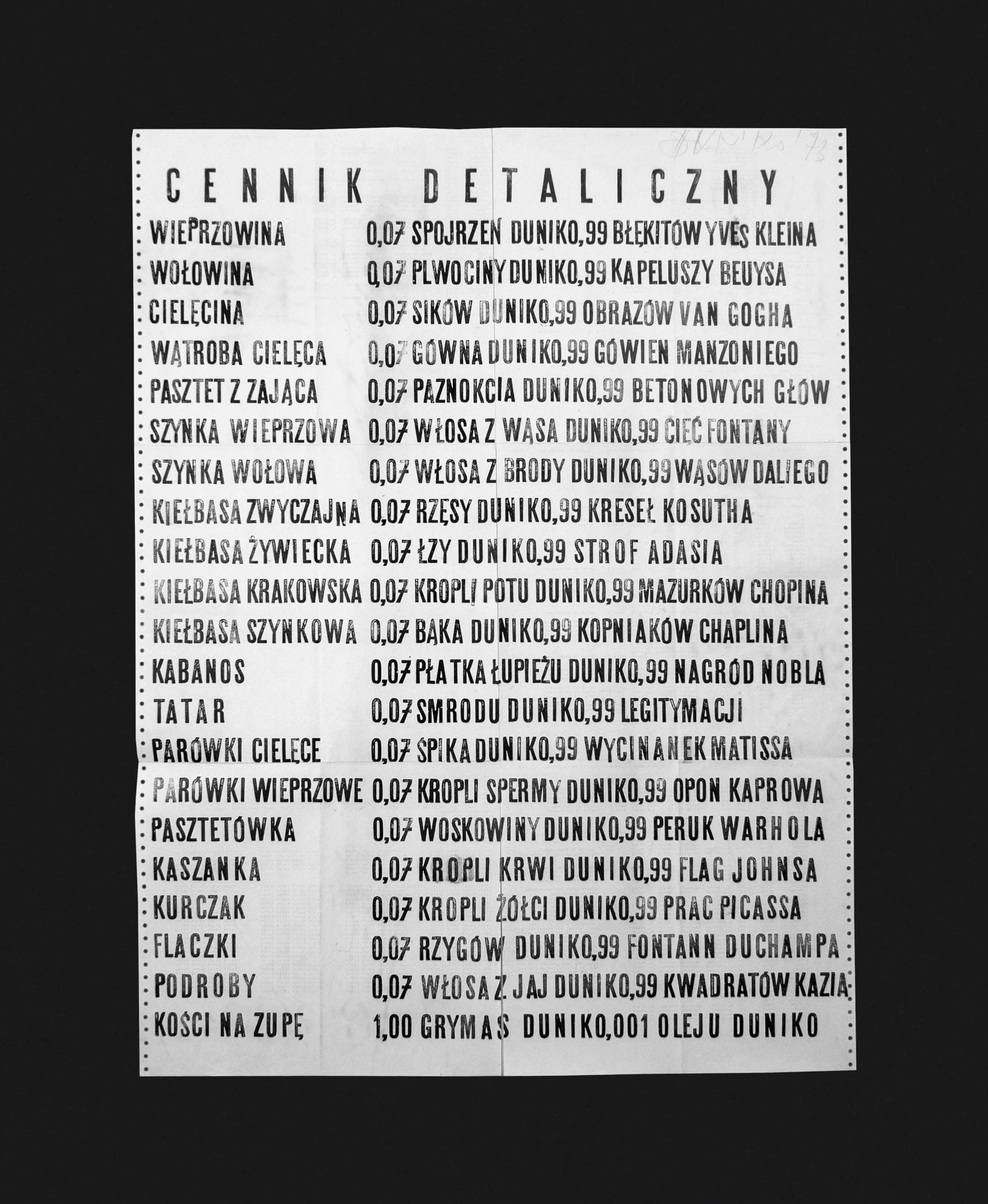
Wincenty Dunikowski-Duniko, Pricelist, 1973
“Rebellion does not end, it is merely stabilized” (Stanisław Grochowiak)
From the current perspective, the Polish 1970s appear to have been a period of intense transformations in the realm of art – transformations involving all of its dimensions and features, affecting both its formal and material determinants, as well as institutional circumstances.
Writing elsewhere about that decade1, I accentuated the fact that the alternative, radical artistic formations were at the time abandoning the perception of art in terms of form, style and value – still characteristic for the avantgarde of the 1960s – for the sake of a neo-avantgarde approach, constructed around the notion of (self-)analysis, dematerialization and deformalization of art. The 1970s turned out to be the ultimate move away from the ideology of representation and expression towards projects involving action and communication, from object to function, from visual arts to the media2.
In the text mentioned above – as well as in numerous other publications – I indicated the incontestable significance of the media (media arts) in the shaping of the Polish neo-avantgarde paradigm in the 1970s. Nevertheless, I wish to emphasize clearly that the analytical, deconstructivist, radical tendency in the Polish art of that period did not restrict the scope of its influence to the area of media practices. At the time, an analysis of art was also performed in other circles of alternative artistic endeavors – through decomposing (often ironic) of art’s determinants, debunking its ideological foundations, revealing its institutional claims and problematizing the social status of the artist. All this ultimately led to a transgression and abandonment of the negated figures and forms of art, and to initiating actions which, although still bearing the artistic status, were located outside the borders of art3. This activity may be described as a game with art – a game conducted both against it and in its name. This game, despite its often ironic character and its ludic elements, was essentially a very serious activity; each instance consisted in shouldering individual responsibility for art’s fate without the comfort of a possible footing in extant conventions and values.
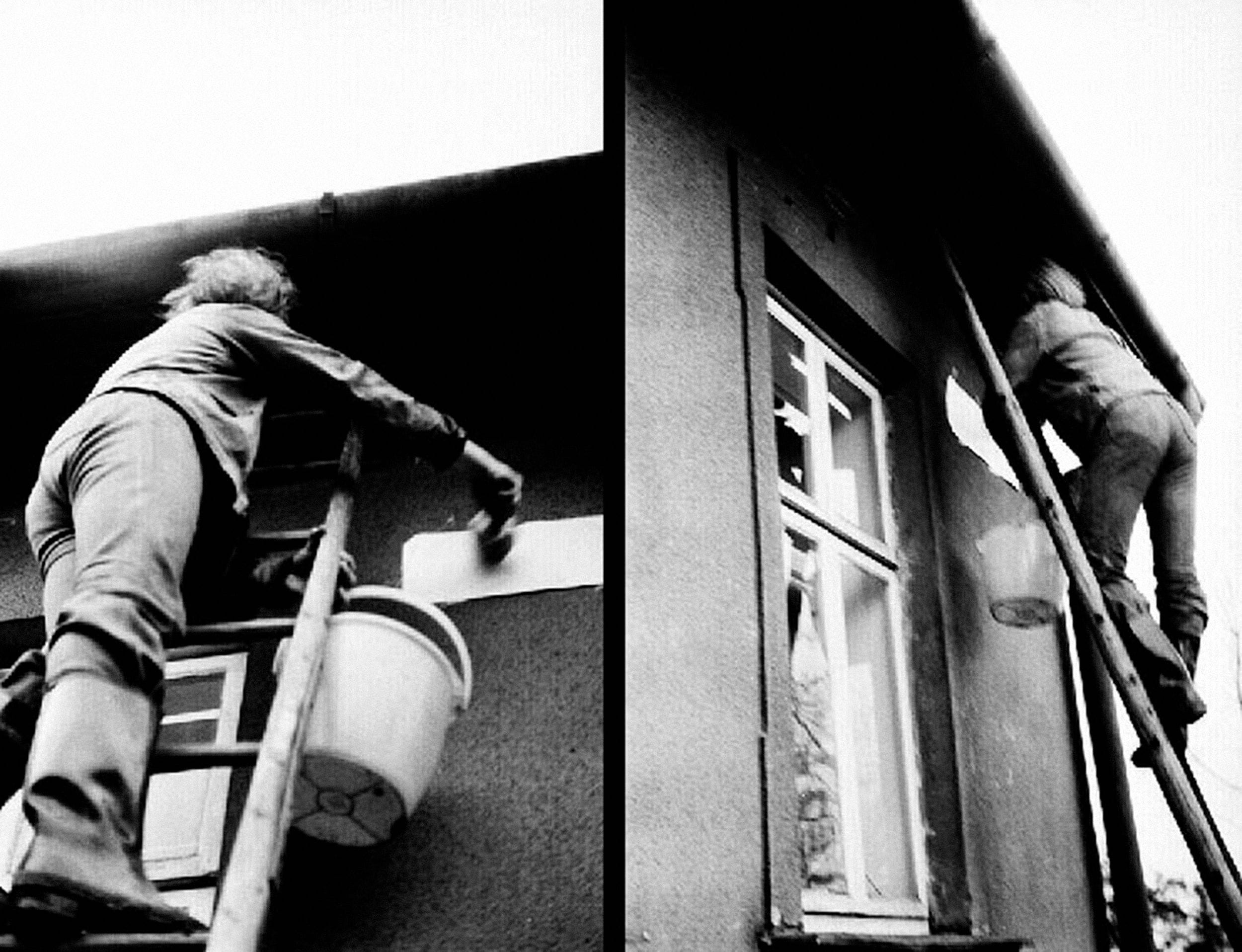
Wincenty Dunikowski-Duniko, Action: Labyrinth, Painting the plates with street names, Nowa Ruda, Poland, 1973
The area of art perceived as a game seems to me an exceptionally appropriate context for reflections on the work of Wincenty Duniko-Dunikowski.
Dunikowski’s art not only originates from, but still belongs to the circle in which art assumes the form of a unique set of games, outlined above. His affiliation with the artistic formation which emerged in the 1970s and lent impetus to the attitude/tendency described herein is hardly debatable4. Instead, I wish to consider the character of Duniko’s approach during this source period, as well as its subsequent continuations and transformations. We are already at a remove of almost a quarter of a century from that decade, and Dunikowski’s art has, in the course of time, undergone many significant alterations.
In the first half of the 1970s Dunikowski’s artistic practices were often located on the border between art and extra-artistic reality. The projects realized in public spaces transcended both the institutional frames of artistic endeavor – abandoning its sacral spaces and relocating to the street or to places of public convenience – and the notions of representation, characteristic for visual arts, replacing them with text or action (Groceries; Anybody does Know (Who Knows); The Labyrinth; Painting Over Street Plates). Thus, the undertaken game involved art as much as the external reality, but simultaneously it abolished and annulled the boundaries between the two. The object of this game was art as a notion and as a phenomenal whole, art as a separate and autonomous enclave of reality.

Wincenty Dunikowski-Duniko, Computer landscape, 1974
The final effect of this game, if played to its logical end, would have been art’s dissolution in the reality external to it, a significant consequence of which would also have been a transformation of that reality, an endowment with new values. In other words, the conclusion and the immanent goal of that game would have been a realization of a utopia which has motivated numerous avant-garde movements since the inception of the twentieth century; namely, the utopia of a desired end to art, resulting from a transformation of reality understood totally.
However, this conclusion of art – at times occurring on the personal plane, where an individual gesture manifesting rebellion and rejection of art may possess a genuine causative power (the artist, like Arthur Rimbaud, may lead art towards its own termination in the context of his own existence, i.e. abandon art) – has never come to pass and its deliberate fulfillment on the social plane will never be possible. Art, similarly to every other element or factor of culture, is a collective creation. An individual gesture does not have much of an influence on the fate of art, and, more precisely, it cannot contribute significantly to the decline of the latter. The individual end-to-art game is endless. Therefore, perhaps, sooner or later a game of this sort will be transmogrified, unnoticeably, into another game – one whose object is not endurance, but merely the quality of endurance. The object of this game is no longer art as a notion, or art as a whole, but its particular features, elements, conventions or qualities.
In the context of Duniko’s art, this change of the game’s object is so imperceptible that it is difficult to indicate the boundary moment. This, however, should not be surprising. It is a feature of such games, after all, that if a change occurs, it is total and timeless – everything that has happened thus far in the game is altered. What constituted the first game becomes the second; the game continues. In the first game, the question was: “what is art?” In the second, the question is: “when does art occur?” Are these, however, two different questions?
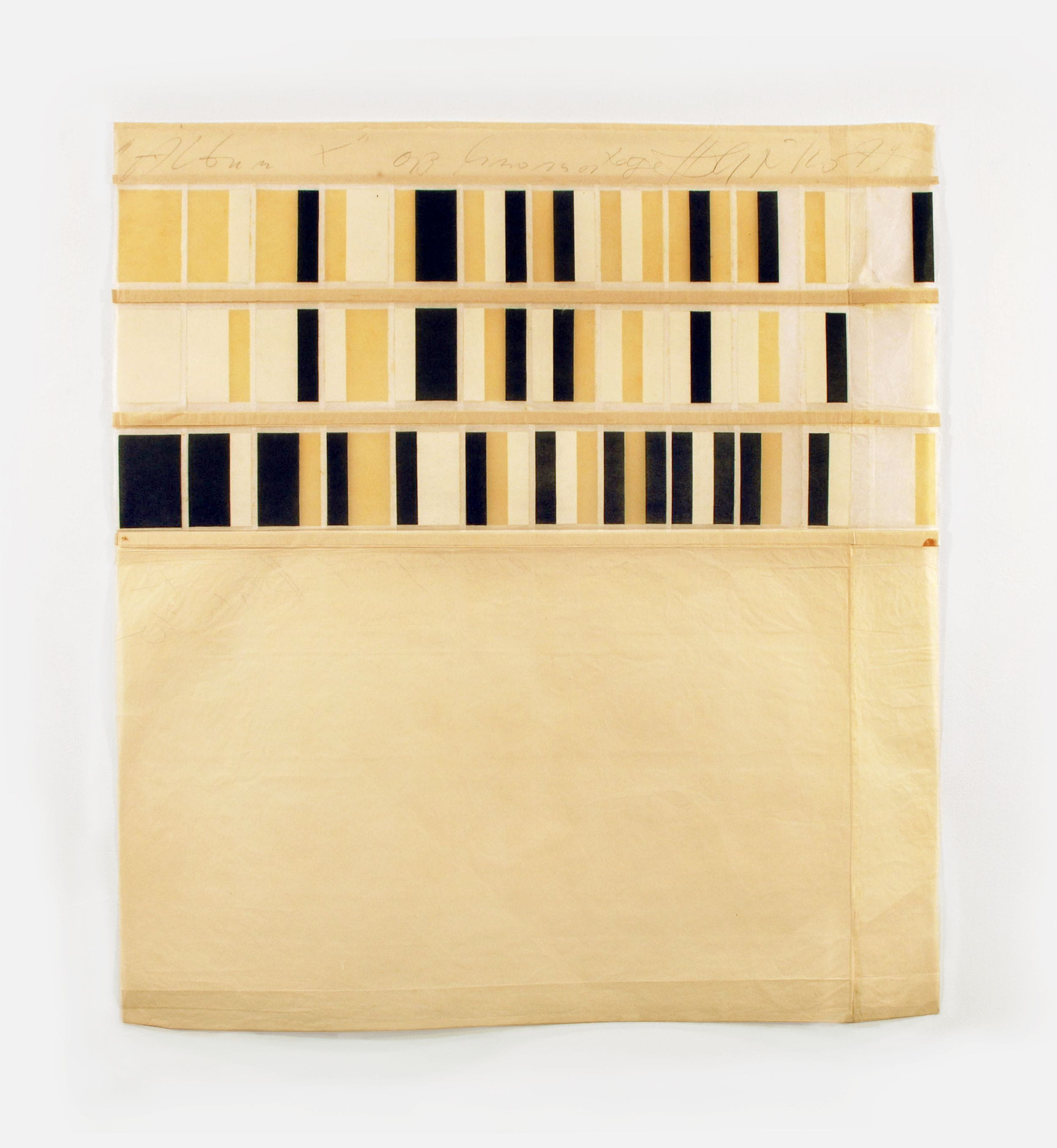
Wincenty Dunikowski-Duniko, Album X, 1977
In the second game as played by Dunikowski, like in the preceding one, impermanence and transience have the lead roles. In the first game, the work of art assumed the form of an event. The performative, action-oriented character of those events meant that they passed, leaving behind objects – traces: a photographic record, a note, a text which was a mere fragment, and therefore a trace of a non-existent whole. In the second game, however, impermanence becomes the attribute of the produced object, which is no longer a trace, nor does it point to anything that would precede it. Duniko employs impermanent materials, such as paper (the Stamp Albums and Crumpled Screens cycles), most likely on account of this very quality. The objects, like Duniko himself, incessantly but imperceptibly undergo change. ‘Moment art’. The art of a moment or the art of a process? The art of a moment and the art of a process?
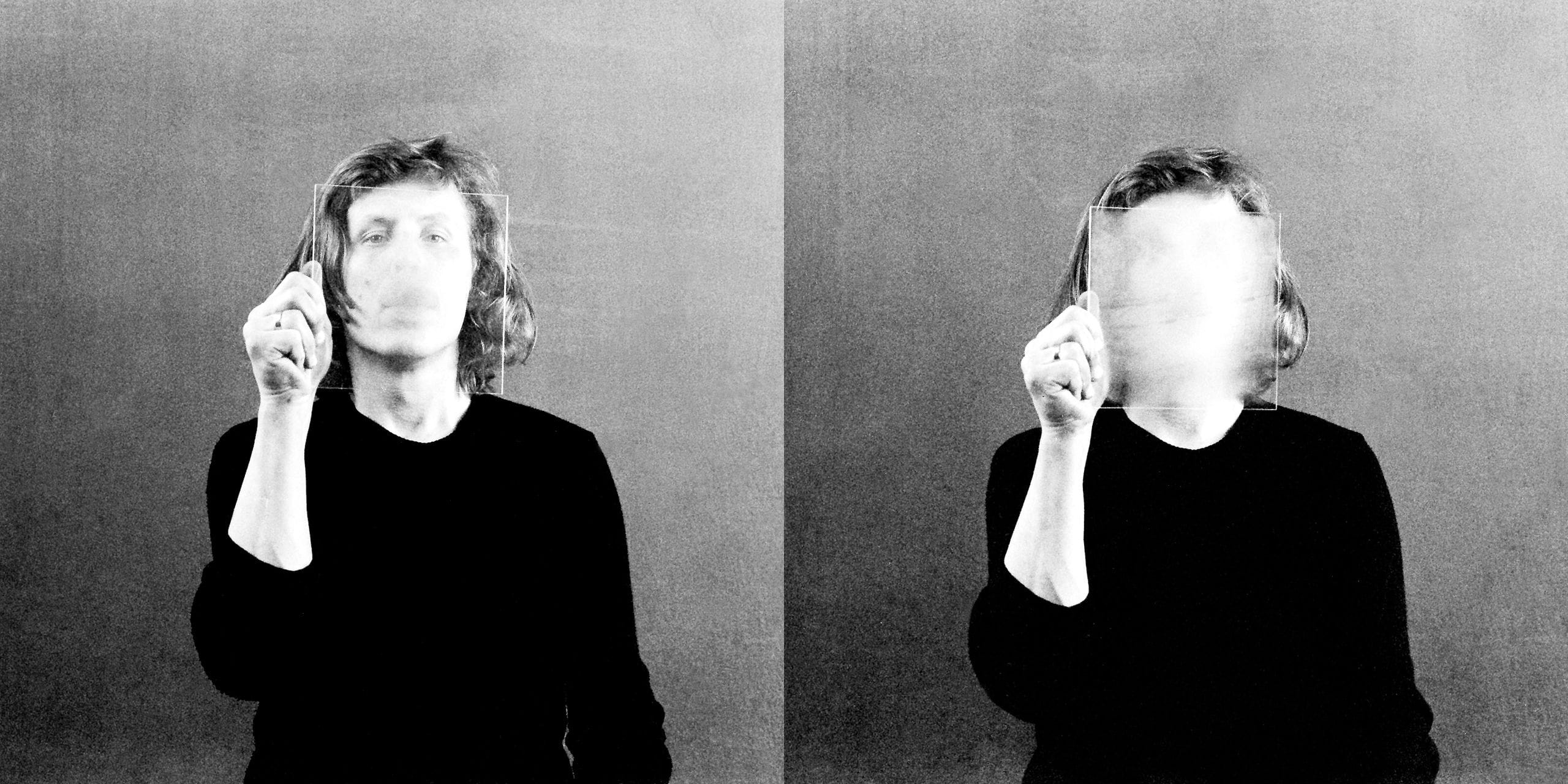
Wincenty Dunikowski-Duniko, Duniko's breath, 1976
Occasionally the two games coalesce, transcending the temporal order and creating hybrid forms. Duniko’s Breath – a record of a moment and, at the same time, an object which immortalized the moment. The object and the process in mutual penetration. The stratification, differentiation and positioning within mutual references continues endlessly. The transparency of the plate commences a game with the solidity of the material object. The visual representation located on the plate lends itself to viewing from both sides – the window changes into a mirror. When does art occur? In the moment of the breath or in the eternity of the trace?
The third game finally forces us to consider the recipient. Why have we not done so earlier? After all, art always involves a recipient. A probable reason for this neglect of a factor indispensable to artistic communication is that the first two games were primarily the artist’s games. It was he who posed questions for himself through his works – questions concerning art, reality and their mutual relations. Even if these questions did not lead to any decisive answers (which is usually the case with art which consistently seeks new horizons), even if they were sometimes asked only instinctively, without the awareness of posing a question, they invariably concerned first of all the subject of artistic events – their prime mover – in relation to those events.
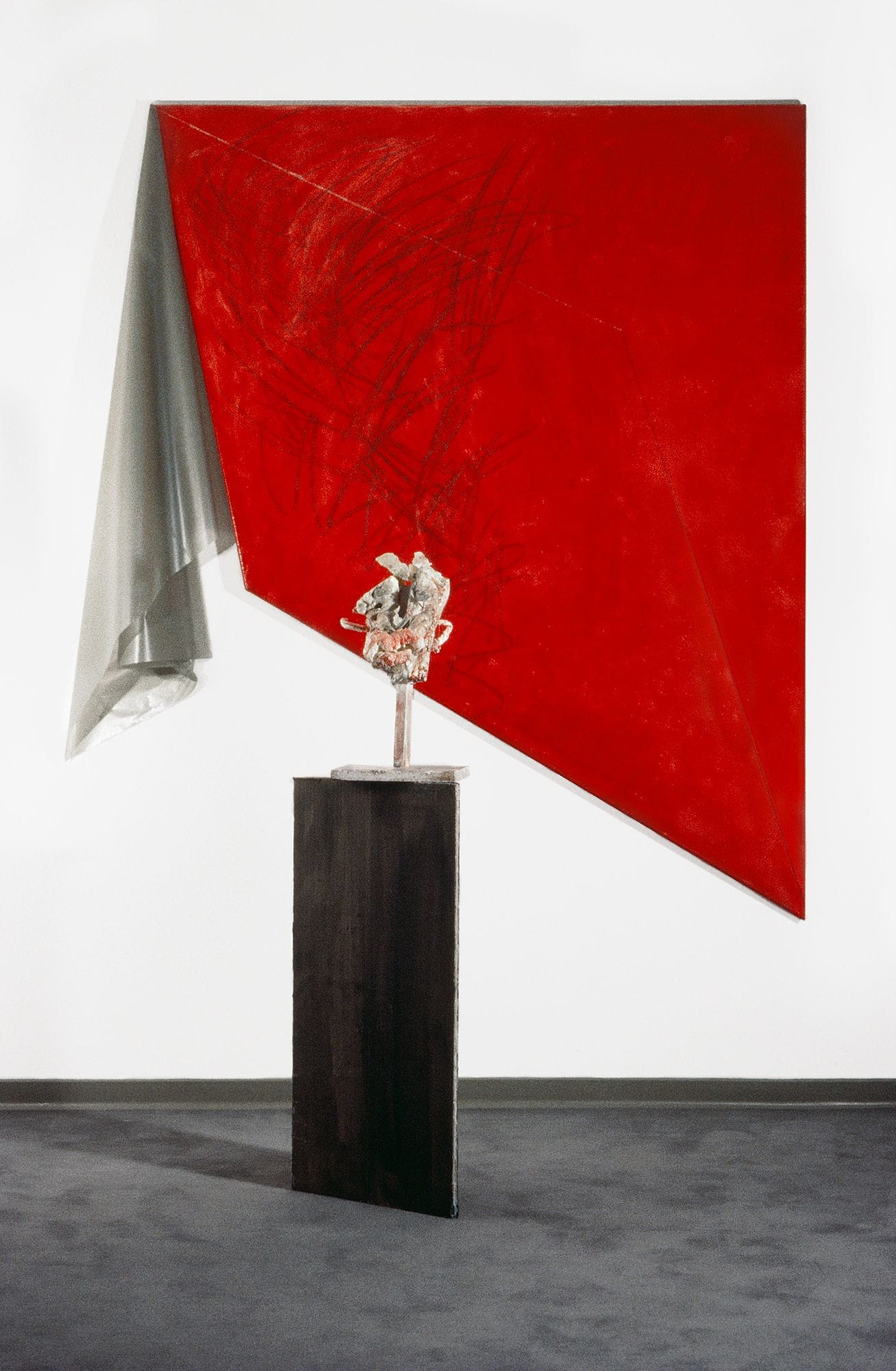
Wincenty Dunikowski-Duniko, New “New” Revolution, 1983 and Self-portrait with a Torn Ear, 1984 at the exhibition: New “New” Revolution, Galerie Marina Dinkler, Berlin, Germany, 1986
Now, the structure of the works begins to reveal an intensifying awareness of the Other’s presence. The works from the Ready for Use cycle, or from its extension, The New New Revolution, assume the form of a singular invitation for the viewer to collaborate mentally. The Current Program project, in turn, returns to the public space in which Duniko’s early artistic actions were realized. This time, however, this area is perceived as the domain of the audience, as a space of social interaction with an increasing presence of various institutions, as a space appropriated by the cultural industry.
The fourth game, like its predecessor, is a game with the audience; nevertheless, it differs from the previous one. The reception of works from the Point of No Return cycle assumes the form of an epistemological game of sorts, one in which the structure of interpretative activities undertaken with regard to art becomes a model for all epistemological actions, especially those aimed at the environment which is active, fluctuating and which incessantly shapes its existence and form.
It is only in the context of this last game that we discover in Duniko’s work a return of traditional artistic values. Form, color, texture, the plane, the solid unexpectedly become the all-important factors in Dunikowski’s newest works. Having made this discovery, we also notice that those factors have practically always been present in his art.
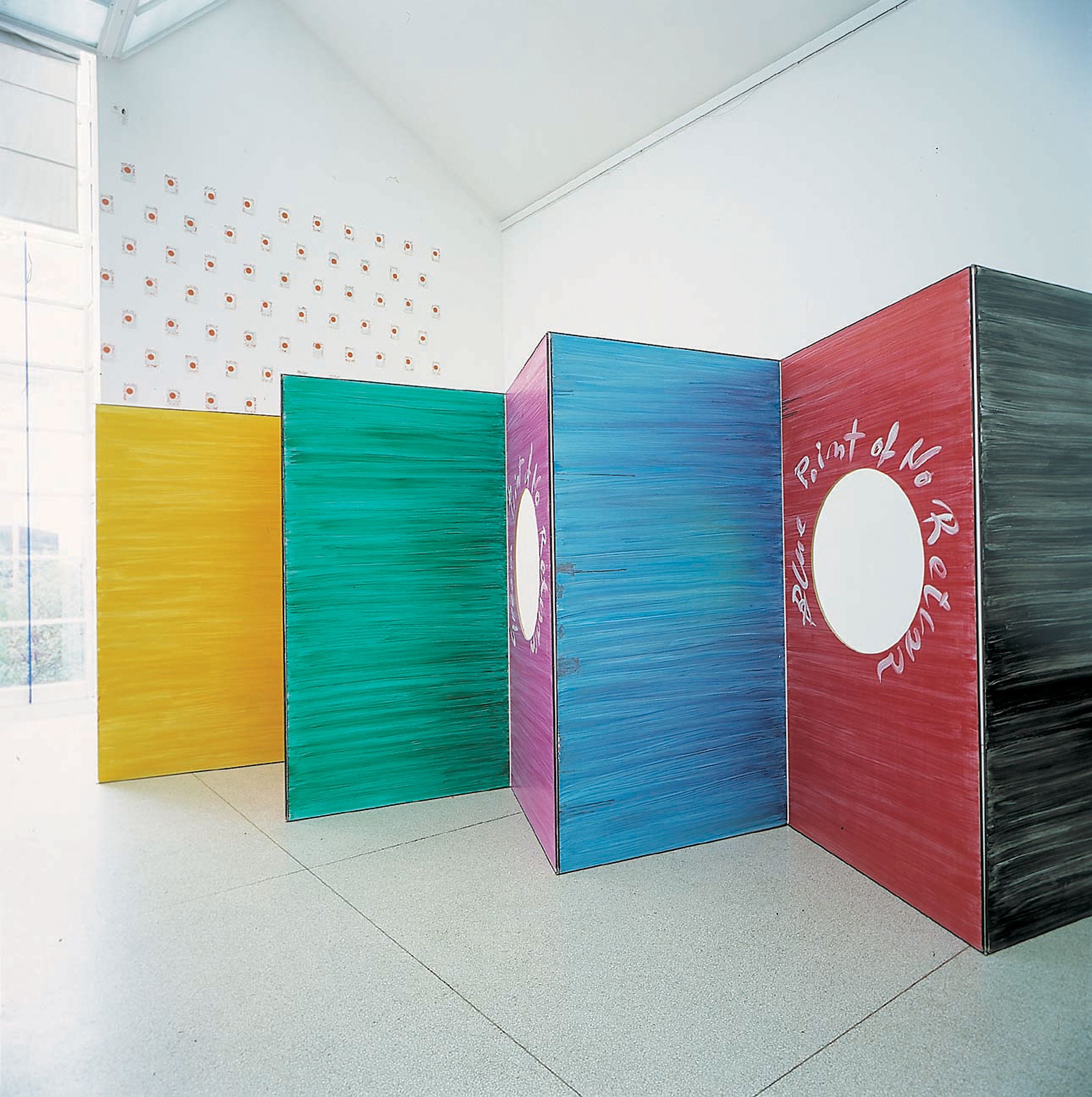
Wincenty Dunikowski-Duniko, Points of No Return, 1992. Exhibition at Heidelberger Kunstverein, Heidelberg, Germany, 2001
However, in earlier phases they were relegated to the background and seemed not to participate significantly in the games played there. Contrariwise, in the current epistemological game, it is these factors which conduct it, organizing and disorganizing the reception and interpretation of the experienced phenomena. This affects the status of those artistic qualities; organizing the game, they simultaneously become a part of it; they are subordinated to its principles. Escaping the reign of traditionally understood aesthetics, they fall under the sway of game theory and the logistics of creative practice.
All of the games separated for discussion above – and their actual number is certainly much higher – define the dynamics of the transformations which Wincenty Dunikowski’s art undergoes. They determine the process in which ever newer orders are forged to organize the course, structure and features of artistic events. They establish the mutual relations between the elements of artistic communication. Significantly, they also introduce invariable elements and qualities into this world of constant flux, supporting (or expressing) the permanence of Duniko’s attitude.
“Rebellion does not end, it is merely stabilized,” wrote Stanisław Grochowiak in one of his poems. Such is the case with Dunikowski’s art; in its miscellaneous forms it maintains a consistently critical reserve towards the changing environment. It combines the permanence of the approach with the mutability of its expression.

Wincenty Dunikowski-Duniko, Untitled, 1988. Duniko's solo show at Pomeranian Dukes’ Castle, Szczecin, Poland, 1993
Info
The text was originally published in the magazine Kultura Współczesna No 1/2004 as part of the article: Awangarda w ponowoczesności (Avant-garde in Postmodernity) and also on the O.pl Polish Culture Portal on September 27, 2006.
Notes
1 Cf. Ryszard W. Kluszczyński, Warsztat Formy Filmowej 1970-1977 (The Workshop of the Film Form 1970-1977), CSW, Warszawa 2000.
2 Ibidem, p. 10-11.
3 Just as the practices of an analytical-deconstructivist character were not restricted to media arts, so the ironical actions, decomposing artistic institutions and revealing the pretence of artistic authorities did not shun the contacts and relations with the media. All those qualities appeared in miscellaneous arrangements and configurations, defying attempts at hasty, simplistic summarizing; cf. e.g. the text entitled Tożsamość sztuki – tożsamość artysty. O twórczości Józefa Robakowskiego (The Identity of Art – the Identity of the Artist. Reflections on the Work of Józef Robakowski), a chapter in my book Obrazy na wolności. Studia z historii sztuk medialnych w Polsce (Images at Large. Study on the History of Media Art in Poland), Instytut Kultury, Warszawa 1998.
4 Although his first works were produced in the 1960s, the entire 1970s neo-avantgarde is rooted in the experience and the radical experimentation of the new avant-garde of the preceding decade.